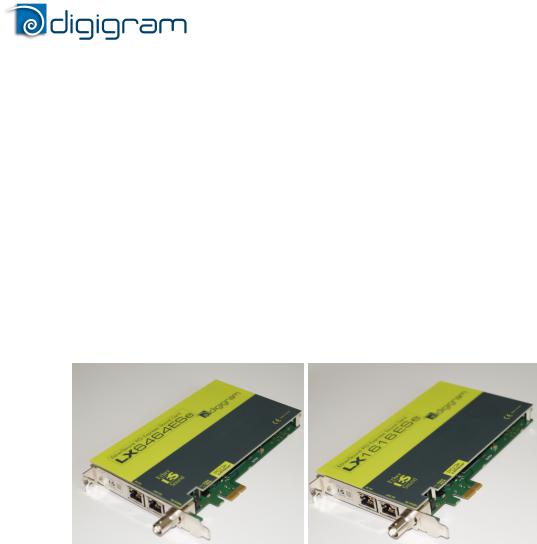Digigram LXIP User Manual

LX1616ESe/LX6464ESe
User manual
LX1616ESe
LX6464ESe
EtherSound PCI Express Sound Cards
User manual v0.99

LX1616ESe/LX6464ESe
User manual
For technical support, please contact your cardsupplier
Copyright 2014 Digigram. All rights reserved.
No portion of this manual may be reproduced without prior written consent from Digigram. The copyright protection claimed here includes photocopying, translation and/or reformatting of the information contained in this manual.
While every effort has been made to ensure accuracy, Digigram is not responsible for errors and omissions, and reserves the right to make improvements or changes in the products and programs described without notice.
Digigram, the Digigram logo, LX1616ESe and LX6464ESe are registered trademarks or trademarks of Digigram S.A.. All other trademarks are property of their respective holders.
Digigram S.A.
82/84Allée Galilée,38330 Montbonnot-Saint-Martin,FRANCE
Tel:+33(0)47652 47 47•Fax:+33(0) 47652 18 44•E-mail:info@digigram.com
Digigram Asia Pte Ltd.
60 Albert Street - #19-11OGAlbert Complex Singapore 189969,Singapore
Tel :+656291 2234•Fax :+656291 3433•E-mail :info_asia@digigram.com

LX1616ESe/LX6464ESe
User manual
Table of contents
INFORMATION FOR THE USER
IMPORTANT NOTICE
FEATURES
LX1616ESe main hardware features
LX6464ESe main hardware features
Main software features
EtherSound features
REQUIREMENTS
Minimum requirements
Software requirements
Supported operating systems
HARDWARE INSTALLATION
Installing the card
Interrupt and memory address
SOFTWARE INSTALLATION
Installation under Windows 7, Windows 8, Windows Server 2008
Removing the driver under Windows XP and Windows Server 2003
Removing the driver under Windows Vista and Windows 7
HOW TO CHECK THE INSTALLATION
Windows XP and Server 2003
DIRECTSOUND CONTROL PANEL
ASIO CONTROL PANEL
CLOCK AND ROUTING
SPECIFICATIONS
Configuration
Inputs/Outputs
Connectors
EtherSound
Audio specifications
Development environments
APPENDIX
LX1616ESe/LX6464ESe schematic diagram
Connectors

LX1616ESe/LX6464ESe
User manual
INFORMATION FOR THE USER
This device complies w ith part 15 of FCC rules. Operation is subject to the follow ing tw o conditions: (1) This device may not cause harmful interference, and (2) This device must accept any interference received, including interference that may cause undesired operation.
This equipment has been tested and found to comply w ith the limits for a CLASS B digital device, pursuant to Part 15 of the FCC Rules. These limits are designed to provide reasonable protection against harmful interference in a residential installation. This equipment generates, uses, and can radiate radio frequency energy and, if not installed and used in accordance w ith the instructions contained in this data sheet, may cause harmful interference to radio and television communications. How ever, there is no guarantee that interference w ill not occur in a particular installation.
If this equipment does cause harmful interference to radio or television reception, w hich can be determined by turning the equipment off and on, the user is encouraged to try to correct the interference by one or more of the follow ing measures:
●reorient or relocate the receiving antenna
●increase the separation betw een the equipment and the receiver
●connect the equipment into an outlet on a circuit different from that of the receiver
●consult the dealer or an experienced audio television technician.
Note: Connecting this device to peripheral devices that do not comply with CLASS B requirements or using an unshielded peripheral data cable could also result in harmful interference to radio or television reception. To ensure that the use of this product does not contribute to interference, it is necessary to use shielded I/O cables.
The user is cautioned that any changes or modifications not expressly approved by Digigram could void the user’s authority to operate this equipment.
Warning:
Electrostatic discharge (ESD) can damage several components on the board. To avoid such damage in handling the board, take the following precautions:
Bring the device and everything that contacts it to ground potential by providing a conductive surface and discharge paths. As a minimum, observe these precautions:
●
●
●
Disconnect all power and signal sources.
Place the device on a grounded conductive work surface.
Ground yourself via a grounding wrist strap or by holding a grounded object.
●Ground any tool that will contact the device.
IMPORTANT NOTICE
This card has been tested and found to comply w ith the follow ing standards:
●International: CISPR22 Class B.
●Europe: EMC 89/336/CEE (1992) specifications.
●United States: FCC Rules-Part 15-Class B (digital device).

LX1616ESe/LX6464ESe
User manual
FEATURES
LX1616ESe and LX6464ESe are audio cards for PCI EXPRESSTM x1 (PCIe®) bus, and can be inserted in PCIe® (x1, x4, x8 ou x16) slots.
LX1616ESe main hardware features
●16 EtherSound ES-100 mono inputs at 44.1 kHz or 48 kHz
●16 EtherSound ES-100 mono outputs at 44.1 kHz or 48 kHz
●1 standard Word Clock input with selectable input impedance
On the LX1616ESe, EtherSound I/Os can be added by up to three bundles of 16/16 channels through a software key. For this option, please contact your system supplier.
LX6464ESe main hardware features
●64 EtherSound ES-100 mono inputs at 44.1 kHz or 48 kHz
●64 EtherSound ES-100 mono outputs at 44.1 kHz or 48 kHz
●1 standard Word Clock input with selectable input impedance
Main software features
●Real-time, simultaneous record and playback in PCM (16 and 24 bits)
●Low latency WDM DirectSound and ASIO drivers.
●Card can be used through the following programming interfaces (APIs): DirectSound kernel streaming, DirectSound, WASAPI, ASIO.
EtherSound features
●EtherSound ES-100 compatible
●The card can generate the network audio clock, or it can synchronize on the network audio clock
●Network clock and audio clock frequencies supported:
-48 kHz if the card generates the audio clock source for the network
-44.1 kHz or 48 kHz if the card synchronizes on the EtherSound network or on an external Word Clock
